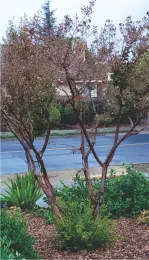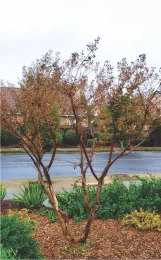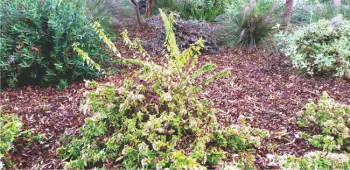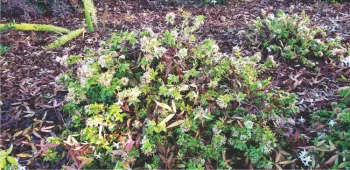by Melody Kendall

Currently there are four demonstration gardens for the community to observe and enjoy at Las Flores community center: the Low-water/low-maintenance Garden, a California Native Garden, a Pollinator Garden and a Succulent/dry Garden.
There are three trees in this garden. The Raywood Ash and the four Crape Myrtle trees were on the site when the garden was developed. Saving these trees shows that, when redoing or developing a landscape, it's possible to save some established trees. The three arbutus trees are new additions.
Fall cleanup of the trees:
The Raywood Ash
Requires little fall cleanup other than the raking up of the fallen leaves.
Leaving or removing the leaves is up to the gardener. The leaves provide natural fertilizer and mulch but can be unsightly and blow into walkways etc.
After leaves have fallen we will check the tree for any dead or broken branches and remove those

Prone to suckering at the base of the tree, so fall cleanup includes the removal of those suckers.
Crape Myrtles drop their leaves later in the winter thatl need either removal or dispersal into the soil. Once the branches are revealed shaping the trees can be done.
Arbutus unedo
The bark of these trees exfoliates and some fallen fruit at this time of year should be cleaned up, but basically these trees require little fall cleanup.
Being evergreen, these trees will have constant leaf drop, but never excessively.
Other plants were also included in the fall cleanup.
Little Ollie olive- No fall cleanup, just general shaping in the spring to keep the desired size.
Pink Muhly grass- No fall cleanup. The flower plumes are a fall feature and as they dry into the winter food for the birds. In late spring we will need to cut back the plants to 4 inches in a mounded shape.
Yellow twig dogwood- Deciduous, so will require some leaf debris removal and, once the leaves all fall and the branches are visible, shaping will be done to keep the plant's height and width.

Kaleidoscope Abelia- This plant has a globular growth habit but will send out tall upward and long sideways branches that will need to be removed in the fall and infrequently throughout the year to maintain the globular shape.

Carpet Rose- The carpet roses are still leafed out and in some cases blooming, so pruning will wait until later in winter.
Red Loropetalum- No fall cleanup, only infrequent general shaping to keep the desired size.
Meyeri Fern- Removal of dead branches is all that is required as fall cleanup for this plant. This plant requires little or no maintenance otherwise.
This selection of plants provide excellent examples of low-maintenance plants. The goal for the overall look aims toward a more natural look rather than a formal look. When pruning, reaching into the plants to remove the shoots closer to the interior and the base of the plant so the plant doesn't look "barbered." The Muhly grass is the only exception as it requires a full hair cut in the spring.
The next installment will look at the LFLG California Native Garden, the benefits of creating such a garden and talk about choosing plants for creating a California native garden of your very own.
Napa Master Gardeners are available to answer garden questions by email: mastergardeners@countyofnapa.org. or phone at 707-253-4143. Volunteers will get back to you after they research answers to your questions.
Visit our website: napamg.ucanr.edu to find answers to all of your horticultural questions.
Photo credits: Melody Kendall
Information links:
UCMG Napa County-LFLG webpage
Low-water/low-maintenance garden plants
https://napamg.ucanr.edu/demogarden/g2/

